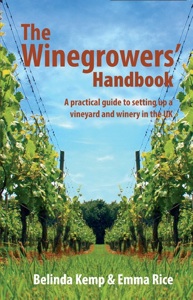The Winegrowers’ Handbook
| Title of book: | The Winegrowers’ Handbook – a practical guide to setting up a vineyard and winery in the UK |
| Author: | Belinda Kemp and Emma Rice |
| Publisher: | Posthouse Publishing |
| Publication date: | 2012 |
| ISBN | 978 1 903872 28 4 |
| Pages: | 224 |
| Price: | £9.95 |
 Given the justified flush of enthusiasm for UK wines this is a timely addition to the library for anyone looking to become better acquainted with the practical and environmental challenges of viticulture in the UK, though its clear focus is for folk thinking of setting up their own vineyard and making their own wine, in the garden or more expansively.
Given the justified flush of enthusiasm for UK wines this is a timely addition to the library for anyone looking to become better acquainted with the practical and environmental challenges of viticulture in the UK, though its clear focus is for folk thinking of setting up their own vineyard and making their own wine, in the garden or more expansively.
The UK’s long history of viticulture is outlined, from Roman introductions to the 40 vineyard listed in the Doomsday book. An abbreviated history of UK viticulture cites the major contributors to the industry, as well as tracing the early days of sparkling wine production to around 1970, and of sparkling wine from chardonnay, pinot noir and pinot meunier to the mid-1980s. Some of the country’s now leading lights of sparkling wine production started in 1988 (Nyetimber), 1989 (Camel Valley) and 1995 (Ridgeview).
The book contains nearly two dozen case studies of individuals’ stories of how each was inspired to become part of the UK wine production industry, their learnings, challenges and insights.
It really does start from scratch telling the novice grape grower such things as where to register their hobby vineyard, what size to stay under to avoid the need to deal with the business end of customs and excise, licensing regulations, etc., where to plant, where to find grapevine suppliers, suited grape varieties, what kit is needed for basic winemaking, the fact that (unplanted) land prices in Kent at the beginning of 2012 were around £10,000/acre, indeed, the whole caboodle for the beginner. As an introduction to viticulture and winemaking manual it has much to commend it. Numerous web references direct the reader to all sorts of detailed and practically useful, and necessary, information
The scale addressed goes beyond the garden as the book progresses, providing information sources on buying land or existing vineyard, site selection, land preparation, vineyard design, (all of which took 18 months for Gerard and Jonica Fox at Hobdens Vineyards in East Sussex), trellising, tractors and their turning circles.
Sustainable, organic and biodynamic cultivation are considered along with a list of organic vineyards in the UK, and those using some biodynamic elements of production. Will Davenport of Davenport Wines in East Sussex shares his organic learnings in the viticulturally tough, rainy, cool and unpredictable climate that is the UK. Soil health comes out on top.
As well as being taken step by step through the winemaking process, the reader is taken through the pros and cons of contract winemaking versus your own winery, plus all the kit a well-equipped winery may need. We’re reassured we don’t need to buy it all in the first year, though we may have to buy it from mainland Europe as the UK doesn’t necessarily stock the most suitable for particular needs.
The book also addressed marketing considerations, from cellar door sales to farmers’ markets and online exposure. Legal and regulatory information is included, all of which makes this a good one-stop-shop information source for anyone thinking of planting a vineyard. It may even deter a few with all the controls in the industry, and that may save those few from making the wrong decision. The book does what it says on the tin.
The layout and paragraphing are not particularly easy on the eye, so I found reading it a not especially relaxed experience, but these are negligible niggles really in what is a hugely practical book, written in simple language.
Comments
2 Responses to “The Winegrowers’ Handbook”




March 4, 2014 at 9:43 am
Hi,
I really want to buy this book – but can’t find it in stock anywhere…please can you advise where it can be bought?
Many thanks,
March 14, 2014 at 1:33 pm
May I suggest you email the publisher? There is a link on the article. Sally